|
Too
often, mainstream audiences are dismissive of Japanese
animation, or anime as it is more widely known. They think it's
all about big robots with transformation skills and wide-eyed
young girls and frown-faced young boys with superhero leanings,
a subject for parody and not to be taken seriously. And
sure enough, you'll find plenty of that. But show me a live action
drama in the past couple of years with the semi-abstract
narrative complexity of Ghost in the Shell 2: Innocence, the sense of apocalyptic vision of Akira,
or the sheer unbridled imagination of Spirited
Away. And it's a myth that anime is targeted
primarily at kids – in Japan, the mainstream anime audience
(and in Japan anime feature films play in cinemas alongside the latest
Hollywood blockbusters) covers a wide age and even social range. The very
first time I laid eyes on a working Sony PSP was on a Japanese
commuter train, which a middle-aged, suit-dressed salaryman
was using to watch anime on his journey to work. Several series
and films are targeted very specifically at an adult audience,
their darker tone, graphic visuals and sociopolitical themes
either inappropriate for younger viewers or unlikely to
be fully appreciated by them.
I freely admit that I have seen only a fraction of the anime
series and features that are out there, certainly a lot less than
my esteemed fellow reviewer CNash, whose specialist area
this is and whose knowledge of the genre greatly outweighs
mine. Which, of course, is why the anime discs we received tend to be redirected to his doormat. That I got
to cover Paranoia Agent was, for me, a rather
splendid accident of chance. The release version of the box set arrived at the
same time as a similarly sized set for Serial Experiments
Lain. Both looked interesting, but we each have
busy lives outside of these review pages, so agreed to split
the task, and I got Paranoia Agent. Had
that not happened, I might never have ended up as glued
as I was to one of the most intelligent, involving and thrillingly
realised series I have seen in years.
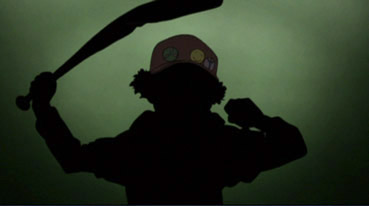
Some
plot to get you started. It's modern day Japan, and young
designer Tsukiko Sagi is under considerable pressure. Creator of the
astonishingly successful Maromi figure (think Hello Kitty
and then some), she is on a time limit to come up with an
equally popular successor, an impossible task that her employers
all gleefully believe she can complete. But the ideas
just aren't coming and Tsukiko is starting to crumble.
Then one night on her way home she is attacked by a young
and mysterious assailant, one dressed in a baseball cap, riding on
roller blades, and wielding a crooked golden baseball bat.
The assault leaves her hospitalised, but the effect it has on her is not as negative as we, and indeed the police, would normally expect. As the case is investigated by gruff, middle-aged
detective Ikari and his younger colleague Maniwa, stories
of further attacks by the figure known as "The Lil'
Slugger" (also referred to as "Shonen Bat") begin to emerge.
Could there be a connection between the victims? Why do
they end up seeing the assaults in a positive light? And just who
is the mysterious Lil' Slugger?
Before
I go on, I should offer a warning. In order to discuss just why
I believe Paranoia Agent to be one of the
best things to sit in my DVD player all year, I need to
reveal a little more plot. Most of the above is from
episode 1, and much of what makes the series so compelling
is not knowing just where the hell it will go next, or indeed
quite where you are at any one time. Speculation and the
process of working it all out are two of its principal pleasures. I promise to keep the spoilers to a minimum,
but if you want to go in completely cold – and that's not
a bad idea – then hop forward to the last paragraph (click here to do so automatically) or go
get your hands on disc 1. That's all you'll need to get
you started.
Although
compelling as a straight drama, Paranoia Agent
really shines in its allegorical subtext,
which runs throughout the series, feeding the narrative like
oxygenated veins (check out the first couple of minutes
of episode 1 and you'll get a taste of things to come).
Do not be misled by the above plot outline – this is not about street crime or wayward youth, but the
pressures that dominate modern Japanese life and by association
that of any modern commerce and competition-driven
society. It quickly emerges that all of those attacked are
under some sort of pressure from those around them, whether
it be workmates, family or their friends and peers. In each case they are
in some small way set free by the attacks. Lil' Slugger is
feared by society, but for his victims he represents a form
of escape. From what? Well, it depends on which episode
you are watching.
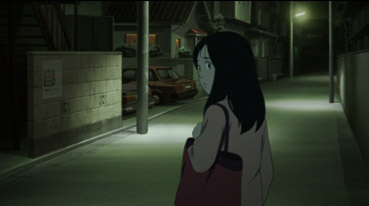
Although
the narrative itself follows a linear path through the
series, the viewpoint shifts from episode to episode. Each of the first four episodes focus on a single potential new victim of Lil' Slugger, and all are revealed to be suffering from a range of social or personal pressures.
In keeping with the subjectivity switch, the design
and animation varies from story to story in inventive but
always appropriate fashion. This is strikingly evident as
early as episode 2, The Golden Shoes, in which
the schoolmates of popular kid Yuichi increasingly suspect
that he is the mysterious assailant, an assumption based
solely on his preference for rollerblades as a mode of transport.
The episode begins in the minimalist-realist style employed throughout the series (objects are geometrically correct and easily recognisable
without the need for excessive detail), then intermittently gives
way to more distorted visuals in order to represent the world from
Yuichi's emotional viewpoint. As a result, the episode,
like Homer's Guatemalan Insanity Pepper trip in the season 8 Simpsons episode El Viaje Misterioso de Nuestro Jomer, can
be admired as much for its design and animation as its storytelling. And yet there's
so much more to it than that. Issues of friendship, schoolyard
popularity, the consequences of hastily passing judgement,
and a whole lot more are explored, and for just about anyone
who did not find their schooldays a breeze, much of what occurs here will be
instantly recognisable. It also tells a solid story in intriguing
and intelligent fashion, with the narrative never overwhelmed by the subtext.
A
similar stylistic approach is taken when the two detectives
finally get to interview a suspect for the attacks, a boy
trapped in a world of fantasy games and comics who imagines
himself as a warrior superhero and his bat as a golden sword
of justice. As he relates events from his distorted viewpoint,
the episode takes on the look and sound of a superhero-orientated
anime, into which the detectives then step to continue their
investigation and interrogation as characters within the
boy's fantasy. In two later episodes, the design and animation
become charmingly simplistic in the style of post-war Japanese
cartoons, as the middle-aged character whose viewpoint we
now share becomes lost in memories of his childhood years and refuses
to face what is happening to him in the here
and now.
As
we move from story to story, the two detectives and Lil'
Slugger remain the only constants, at least at first. In
early episodes there are intriguing hints of narratives
to come, and it is only when a new story unfolds that you
realise that you have already glimpsed part of it in a previous
episode. Only in the final three chapters do all of the
elements and characters come together into more linear approach to the storytelling.
I have to admit this was my least favourite part of the
series – don't get me wrong, this is still terrific and imaginative
stuff, but it does tend to literalise things that until
then had been tantalisingly suggestive, which is just the
way I like my subtextual meat cooked.
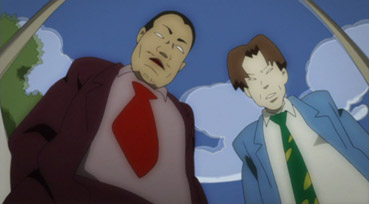
The
show hits a kind of peak of daring and imagination on disc
3, with three very different episodes that are all extraordinary
for differing reasons. Working backwards, Episode 10, Mellow
Maromi, centres around heavily put-upon and luckless
production manager Saruta, who works at the animation studio
that is preparing to produce an animated series based around the Maromi
character and who seems to annoy just about everyone there.
As his co-workers are systematically picked off by Lil'
Slugger, the narrative is intermittently put on hold to
allow Maromi to pop up and explain to the viewer just what
the jobs of the various victims entail, in essence deconstructing
the process of creating the show in which this story is set.
Episode
9, Etc, is a gorgeously devised and structured
piece in which four gossiping women attempt to one-up each
other with their own stories of Lil' Slugger and his victims.
When they run short on anecdotes they take to inventing
them, a tactic exposed when one tells a story whose literary
fame would be instantly recognisable to a Japanese audience but whose
relevance will likely fly over the heads of western viewers.
The stories the women tell are as compellingly
played out as the one that links them, none more so that the
superb visualisation of the terrifying pressure that exams
can exert on the young, especially relevant in a society
in which the pressure to achieve is often quoted as a key contributory
factor to its high youth suicide rate.
But
it's episode 8, the brilliantly titled Happy Family
Planning (see it and see why), that the series visits
its darkest places and explores its most adult themes. It revolves around three
members of an on-line suicide chat group, who agree to meet up
and help each other to take their own lives. Hulking Zebra and
ageing Fuyubachi are both fine with the plan, at least until
until they meet the third member of their group, Kamome,
who turns out to be a relentlessly cheerful and playful
child. Her
jovial attitude is reflected in the tone of the episode,
which is constantly upbeat, even when things are at their
seemingly blackest, which somehow makes the story even more
troubling (see The Missing Scene below). In keeping
with the layering found in the rest of the series, this
is never dark for the sake of dark, but touches on several
problematic aspects of Japanese society (the high national
suicide rate, the fetish surrounding the Japanese schoolgirl
image) and a few that reach beyond national borders (the
potential dangers of chat-room anonymity). And if you're
looking for an ending that initially confuses but on later consideration
astonishes in its subtle suggestiveness, then this is the
story for you.
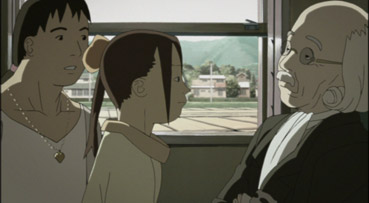
Stylistically
and narratively thrilling moments pop up throughout the
series, from the pavement calculations chalked out by the
old man who delivers the frankly bemusing 'Prophetic Visions'
at the end of each episode, to the sometimes chilling appearances
of Lil' Slugger (never creepier than when seen by both detectives
in their own station after an in-cell murder). But the real
strength of Paranoia Agent, if you put
aside for a moment its excellent artwork and animation,
is its effect as a collective whole. Watch one episode and
you might be intrigued, but watch four in a row and you're
hooked and aching for more. I was left wishing that there
were a live action series around today that had
the sort of intelligence, boldness and narrative complexity
that Paranoia Agent has in abundance, but
at the same time am fully aware that the series is able to do
what it does so well precisely because of the unique
possibilities offered by the medium of animation.
If
you find yourself pre-judging a series because of that anime
label, then it really is time to put that prejudice aside
– you might never otherwise find out what you've been missing.
Director Satoshi Kon was previously responsible for the
acclaimed anime features Perfect Blue (1998),
Millennium Actress (2001) and Tokyo
Godfathers (2003), and far from watering down his style
for television, he has clearly thrived in the episodic nature
and longer overall running time offered by medium, and has
created his most complete and thrilling work to date, and
one that fully deserves to stand on a tall pedestal in the
anime hall of fame.
I
just have to give a special mention to the opening and closing
title sequences, just about the best I have seen in I can't
remember how long. I am fully aware that I am not the first
to celebrate these remrkable bookends and that there have been a number of
on-line discussions, especially in Japan, about their style
and meaning. I admit to being a tad baffled by my
first encounter with both and even skipped past the opening
credits on episodes 2 and 3, so keen was I to get to the
stories themselves, but by episode 5 I was in love with
this sequence. Set to an impossibly exuberant song whose
cut-up style lyrics speak of not worrying about the
tsunami and "a magnificent mushroom cloud in the sky,"
it features many of the main characters individually laughing
straight to camera, standing amidst fast-moving traffic,
on the moon as nuclear war rages on earth in the background,
in landscapes of devastation, or atop a tower in front of
a atomic explosion. What at first looks almost randomly
surreal feels after a few viewings like a portrait of a
society in complete meltdown and a populace on the brink
of uncontrolled hysteria. That it ends on the laughing figure of Lil'
Slugger sends shivers up my arms and spine every time. Oh it's just superb. I've been singing the song
ever since, a task made possible by the odd but welcome
decision to alternately subtitle the lyrics with the English
translation and a Romaji version of the original Japanese.
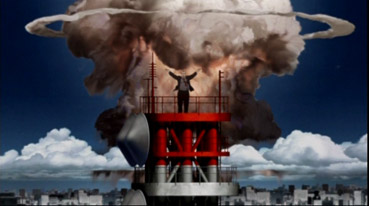
The
end credits offer similarly intriguing reading. Far more
gentle in tone, they feature the same characters all lying
asleep, or perhaps dead, on a grassy meadow. There's certainly
been plenty of debate over this within the realms of Japanese
fandom, and bookended as it is with the apocalyptic opening credits,
the sequence paints a dark picture of where the series may
or may not be heading. That we pull out at the end to see
that the characters are lying in the shape of a question
mark with a giant Maromi figure in its centre only adds
to the intrigue.
But...
I
can't be the only one who, after all this speculation, howled
with dismay when Satoshi Kon reveals
on the commentary that the primary purpose of the exhuberant opening credits
was simply to wake people up (the show was originally broadcast
after midnight in Japan) and then at the end signal that it was
time to go to sleep. I challenge anyone watching them to believe
that's all there is to it – there's even a thread on the
IMDB about the title sequence alone. Either way, it's great
stuff.
If the dark themes of the aforementioned episode, Happy
Family Planning, landed disc 3 an 18 certificate, even
that was to prove insufficient for the BBFC, who insisted
the episode be cut for the UK DVD release. I quote the BBFC
web site:
"To
obtain this category cuts of 1m 20s were required. The
cuts were Compulsory. Cuts required (on potential harm
grounds) to the sight of a child attempting to hang herself,
and accompanying subtitles. Cuts in accordance with the
Video Recordings Act 1984."
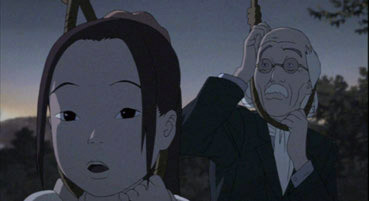
Interestingly,
just one week after I read this, an episode of Casualty
on BBC1 contained a shot of a young girl hanging from a
tree, a live action sequence presented as serious drama
rather than the (very) darkly comic scene that was removed
from this animated series. For the record, the missing sequence
involves all three characters and their attempt to hang
themselves from a tree branch, but Zebra makes a cut to
Kamome's rope so that it will snap at the appropriate moment.
When Zebra slips off the stones he is standing on and begins
to struggle with his rope, Kamome sees this as another fun
game and begins pulling up and down on her own noose as
her two companions start to suffocate. Finally the branch
breaks under the weight of all this and Zebra and Fuyubachi
tumble down the hill with Kamome in chase. If you want to
catch a glimpse of this sequence, watch the 'Prophetic Vision'
at the end of episode 7 – there's a shot from it that the
BBFC appear to have missed.
Anamorphic
16:9, the picture is clean, with good contrast and colour
reproduction, and there's not a lot more you can ask of
an anime transfer. There are signs of an NTSC to PAL conversion,
but it's a good one – there is little evidence of unintentional
blurring on movement.
Dolby stereo
2.0 only, in Japanese or (American) English, the mix is
impressive throughout, with a very good tonal range and
excellent clarity. Sound is really used effectively in places
– the opening couple of minutes of episode 1 are very nicely
layered, though this is better handled on the Japanese track
that the English one. In other respects the English dub
is not a bad job, though the Japanese voice acting definitely
has the edge.
Disc
1
The
Saroshi Kon Interview (5:22)
is a segment from a Japanese TV programme (hence the scrolling
Japanese text that plasters the screen throughout). Despite
its short running time, there's plenty of interest here,
not least Kon's interest in reversing the notions of cause
and effect.
Storyboard
(21:02) provides the storyboards for the entire first episode,
either full screen or alongside the finished artwork.
There
are Trailers for other MVM releases
Samurai Champaloo (1:38) and R.O.D.
the TV (1:32).
Disc
2
The
Opening (Creditless and Japanese)
(3:00) and Ending (Creditless and Japanese)
(2:59) sequences are a standard anime DVD extra.
The
Trailers on this disc are for
Texholyze (1:21) and Gungrave
(1:36)
Disc
3
Japanese
Cover Art consists of 12 covers (6 retail,
six rental) from the Japanese DVDs.
Character
Art is 40 pages of character drawings, including
line art, usually from several angles per sheet. As with
the cover art, these are not full screen.
Disc
4
This
is the big one. Here there is an Audio Commentary
on all three episodes by director Satoshi Kon, writer and
production chief Seishi Minakami and producer Satoki Toyoda.
Subtitled in English, the name of person speaking is titled at the top of the screen, an excellent feature that
I've only seen before on the Spanner Films' DVD releases
Drowned Out and McLibel.
The discussion is rarely screen-specific, but does cover
the opening and closing credits, the production, character
and dialogue, and sound design in some detail. The production of Episode 2
is highlighted as being fraught with difficulties, and Kon
himself seems surprised it has been so celebrated.
The
Trailers here are a seductive
one for Gunslinger
Girl (2:10) and a less so one for Ikki
Tosen (1:26).
Paranoia
Agent has already built up a devoted fan base and
it's easy to see why – it's quite simply one of the finest
series, anime or otherwise, to land on UK shores in a long,
long while. If you are already open to the unique pleasures
of Japanese animation then waste no time in hunting it out
– if you have until now been resistant, then I urge you
to put aside your reservations and let Lil' Slugger swoop
by and knock you for six. Very highly recommended.
|